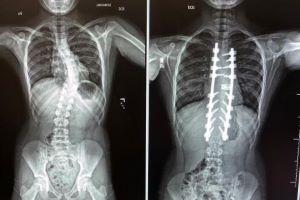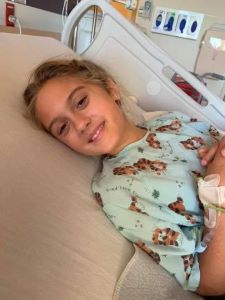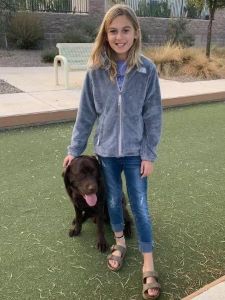- Scoliosis
- Barrow Neurological Institute at Phoenix Children's
- Center for Spine Care
- Orthopedics

At four years old, Mia was like many young girls living in the Windy City of Chicago. She loved hanging out with family and friends and was always on the move, busying herself with dolls, pretending to teach school, riding her bike, tumbling and playing sports.
During one of her youth league soccer games, Mia came to the sideline complaining of pain in her side. At first, her family thought she was experiencing a side stitch, a common muscle cramp that athletes experience in soccer. When Mia’s pain continued for another week, her family sought pediatric care. An ultrasound was performed but didn’t offer any explanation, so her family continued searching for answers.
Mia’s spinal health takes a serious turn
One morning in late October 2014, Mia woke up and couldn’t stand straight. She was leaning toward her painful side. After X-rays and a CT scan, her Chicago-based pediatric team discovered a tumor that was causing a lesion on Mia’s spine. “Her spinal cord was supposed to be approximately the size of a broom stick. At the tumor site, it was the size of a drinking straw,” said Mia’s mom, Leslie.
Mia was admitted to The University of Chicago Medicine Comer Children’s where she underwent emergency surgery to remove the tumor and the impacted parts of her spine, which was later diagnosed as an aneurysmal bone cyst (benign bone tumor). Mia was fitted for a thoracic lumbar sacral orthosis (TLSO) brace, which is commonly used to assist children who have scoliosis and underwent intensive inpatient physical therapy. Nine days later, she walked out of the hospital on her own two feet.
Growing up complicates Mia’s spinal condition
Over the next few years, Mia wore her TLSO brace for support as she continued to grow…fast. By 10 years of age, Mia developed a 25° scoliosis (sideways) curvature and a 55° kyphosis (forward) curvature of her spine. This didn’t slow Mia from enjoying an active lifestyle. “Neither curve required surgery and Mia was a happy, healthy kid who would whip out a back handspring back tuck combo at will,” said Leslie.
Mia’s pediatric team kept a close eye on her spine through X-ray checkups every six months and annual MRIs. In addition to checking for a recurrence of the cyst, physicians were tracking spinal stenosis (narrowing of her spinal canal) caused by her worsening kyphosis curve.
In July 2020, Mia’s family relocated to Gilbert, Arizona. By this time, her kyphosis curve had reached 75° and her Chicago-based pediatric team recommended that Mia undergo spinal fusion surgery as soon as possible.
Mia’s family turns to Phoenix Children’s

New to Arizona, Mia’s family conducted extensive research to find a highly specialized pediatric surgery team they could trust. “After a ton of research, we decided to work with Dr. Jamal McClendon and Dr. David Bennett from the Comprehensive Pediatric Spine Center at Phoenix Children’s,” said Leslie. “They took the time to answer all our questions, exhausted all surgical options and gave us the confidence we needed to move forward.”
Mia underwent successful spinal fusion surgery on November 12, 2020 — almost six years to the day of her first spine surgery. In addition to spinal fusion, Phoenix Children’s multidisciplinary surgical team removed Mia’s compressed vertebrae and replaced it with a titanium spinal cage. This interbody cage is porous and will enable Mia’s spine to continue developing as she grows, without the need for additional instrumentation or back support.
“The doctors gave us some insight into the severity of the condition of Mia’s spinal cord and how surprised they were that she was able to function the way she was prior to surgery,” said Mia’s father, Brian. “They also confirmed there was no evidence of recurrence of her aneurysmal bone cyst, and they expected Mia to make a full recovery!”
During the first six months following surgery, Mia wasn’t permitted to bend, lift or twist. “Recovery was challenging at first. But after a few weeks, Mia started feeling better and moving easier,” said Leslie.
Mia tops all expectations, in more ways than one

During routine post-op checkups with Dr. Bennett, Mia exceeded the team’s expectations of her recovery and her physical exams showed a vast improvement to her pre-surgery posture. “Mia has shown incredible resilience already in her short life,” said Dr. Bennett, pediatric orthopedic surgeon. “With the love and support of her family, her positive outlook and sprit, she has faced, and so far, overcome, this challenge with remarkable courage. We are honored to play a small part in her recovery.”
In turn, Mia’s family shared their thoughts on Dr. Bennett’s family-centered care. “Working with Dr. Bennett during recovery has been amazing,” said Brian. “We were able to contact him with questions as she recovered, and he made us feel like he truly cared about our family.”
Mia recently celebrated her 11th birthday and during her 6-month post-op appointment, Dr. Bennett cleared her to return to her normal active lifestyle. Mia and her family were thrilled, and Mia has since returned to playing competitive volleyball and recreational basketball.
“Throughout her journey, Mia’s personality has shined. To know her is to love her. She is the kindest human being we have ever been around and makes us proud daily,” said Brian and Leslie. “Mia has been through more than many people will go through in their entire lifetime, and she has handled it with a grace and fortitude well beyond her years. She continues to be a leader in her classroom, an amazing daughter, friend, and big sister, and an inspiration to anybody that she meets.”
At Phoenix Children’s, we couldn’t agree more. Mia serves as an inspiration to all others facing a challenging medical condition. She is truly a pillar of strength!
